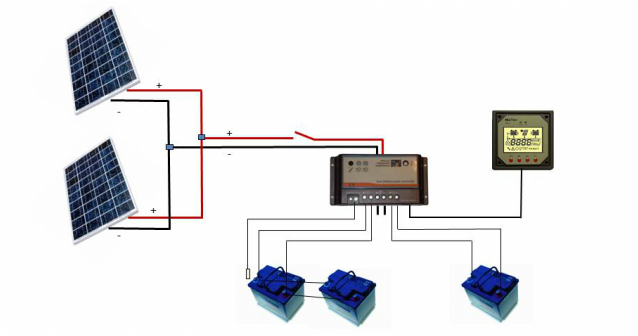 Wiring Diagram for a Two Solar Panel System, a Dual Output Solar Controller and Two Battery Banks Wiring Diagram for a Two Solar Panel System, a Dual Output Solar Controller and Two Battery Banks We are often asked questions about how to wire a solar system. This can appear to be a daunting task for those new to the world of solar but it is actually quite easy and straight forward. In this blog I will walk you through the wiring process for our dual output controller step by step. First, the definition of a few terms: * MC4 Connector - A water proof connector used in solar wiring. Most solar panels come with MC4 connectors attached to 3 foot solar wire pigtail coming from the panel junction box. These connectors are easily disconnected. * Solar Controller - Except for small trickle charge systems, all solar systems should have a solar controller. The purpose of a controller is to prevent batteries from being overcharged, apply the optimal charging current to the battery bank and prevent current from back flowing from the batteries to the solar panel at night. Controllers are sized by their amperage capacity. Controllers designed for residential and commercial (lighting) use are generally overkill and not well suited for marine applications. * Temperature Sensor - This device is connected to the controller and senses the temperature of the battery bank. If the batteries are heating up due to heavy charging, the sensor signals the controller and the controller reduces the charge current appropriately. A temperature sensor is only useful for systems with larger solar arrays as smaller solar systems do not provide sufficient power to over heat the batteries. * Solar Wire - While most any wire can be used in a solar system, solar wire is designed for maximum conductivity and is well insulated with a UV resistant cover. It is typically single conductor and the insulation is .25 Inches in diameter. The wiring diagram below is taken from our dual output controller manual and illustrates the basic wiring required for a two panel system, a dual output controller and two battery banks. Most solar controllers are single output so charge only one battery bank. In this case, it is common to wire the positive wire to the common on the battery 1-2-both battery switch to select which battery bank is to be charged. A few things to note in the diagram: * The two solar panels are wired in parallel using an MC4 T-branch connector, If one panel is shaded, the other panel will still provide full power to the controller. * There is a switch in the positive wire between the solar panel and the controller. This is optional. The purpose of the switch is to turn off the panel should it interfere with the alternator output when the auxiliary engine is generator is running. It has been reported that some smart regulators are confused by the power coming from the solar panel. It sees the sum of the battery charge plus the panel output and senses the batteries are fully charged so goes into float mode prematurely. This is easily remedied by flipping the switch thus disconnecting the solar panel. * The optional temperature sensor is shown to the left of the larger house battery bank. It is simply taped on to the top of the battery. * If you have a battery monitor such as a Link or Xantrex 1000 or 2000, it is important to connect the negative wires from the controller to the shunt of the battery monitor. Otherwise, the monitor doesn't see the power coming in from the solar panel and will give inaccurate readings. * There is a sequence to follow in connecting the solar system. Connect the controller to the battery banks first. Then connect the solar panel to the controller.
18 Comments
KK Batteries is one of the best Inverter Service centre in Chennai. We provide batteries with guarantee thus making us the best Car Battery Dealers in Chennai. We are Inverter Battery dealers in Chennai with various accessible models.
Reply
Rol Lloyd
4/14/2019 01:53:17 pm
I have a 2 bank battery system on sailboat. Two 12 vdc batteries in parallel and one 12vdc battery (STARTING). Show me a schematic for a 2 50w solar panel to keep both banks charged. Also with a switch to disconnect the solar panels.
Reply
tony
12/26/2020 11:29:29 am
Hi,
Reply
Jim Young
7/6/2019 08:15:51 am
Hi Tim,
Reply
Charles
10/13/2022 08:28:25 am
Jim, you should be able to use a relay with a Normally open/Normally closed terminal. When engine is off (relay in normally closed) connect that terminal inline with the solar charging. Use your relay control wires to loop in to the ignition circuit of your boat engine, thus when you start the engine, it opens the relay, allowing your alternator to charge the batteries, and when you shut the engine off, the relay closes, allowing solar to charge the batteries.
Reply
Mark
4/23/2021 05:36:08 pm
Good evening
Reply
Jay
6/12/2021 12:47:00 am
Hello my solar charges good during the day but at night time it just dies what could be draining the batteries nothing is plugged in also
Reply
10/8/2021 08:32:40 am
The simplicity of your presentation is highly-motivating for learning. Please keep it up for your teeming followers.
Reply
10/8/2021 08:35:20 am
Good article with an excellent way of presentation. Keep it up. Thanks for sharing.
Reply
Thanks for pointing out that a temperature sensor would help sense any overheating in batteries. With that in mind, it would definitely be a good investment to have that kind of marine equipment system. My brother should know about this now that he wanted to get his own boat now that he moved into a new place near the lake.
Reply
Elaine
3/8/2022 07:57:47 am
Thank you for sharing this piece, it's a great topic.
Reply
Elaine
3/8/2022 08:24:07 am
Thank you for sharing this piece, it's a great topic.
Reply
1/22/2023 11:43:02 am
Thanks for sharing this tip, really informative and helpful. I'd be using this for my upcoming post. We must all accept it, the value and importance of our role as electrician helping every household be safe including installation of solar power systems. Totally should be done by a pro
Reply
Lance White
3/2/2024 05:09:29 pm
I have a 4 6 volt battery set up (4- 240 amp-hours=960 amp-hours, a tracer 3215rn controller (spec max input voltage = 300 watts @ 12 Volts) and 2 - 300 watt panels (Heliene 72M-360).
Reply
3/3/2024 12:58:35 am
Lance,
Reply
Leave a Reply. |
Categories
All
AuthorThomas Trimmer has been cruising with his Ericson 38 sailboat on the Great Lakes for over 20 years. He has pioneered the use of solar energy for wilderness cruising. He is continually designing and building equipment to simplify and enhance the cruising experience. Archives
April 2024
|
Efficiently Powering Your Vessel/Van. Call/email/chat any time, we're happy to help you work through designing your solar system.
Home Page Solar Panels Mounting Kits Product Page Marine Solar Systems Gallery of Installations Customer Comments Contact Us
Call 248 705-8337 or email [email protected]
Article On How To Size Your Solar Panels For Your Boat
Customer Reviews Return Policy Privacy Policy Shipping Times/Rates
Home Page Solar Panels Mounting Kits Product Page Marine Solar Systems Gallery of Installations Customer Comments Contact Us
Call 248 705-8337 or email [email protected]
Article On How To Size Your Solar Panels For Your Boat
Customer Reviews Return Policy Privacy Policy Shipping Times/Rates

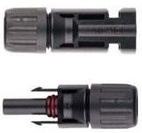
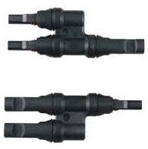
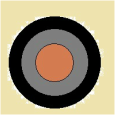
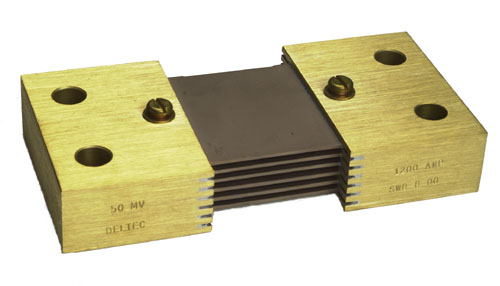
 RSS Feed
RSS Feed